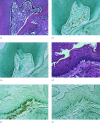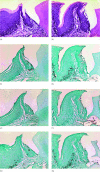Assessment of oral transmission using cell-free human immunodeficiency virus-1 in mice reconstituted with human peripheral blood leucocyte
- PMID: 12757623
- PMCID: PMC1782961
- DOI: 10.1046/j.1365-2567.2003.01644.x
Assessment of oral transmission using cell-free human immunodeficiency virus-1 in mice reconstituted with human peripheral blood leucocyte
Abstract
Oral-genital contact is one of the risk factors for the transmission of human immunodeficiency virus (HIV) in adults. In recent reports, oral exposure to simian immunodeficiency virus (SIV) was found to have important implications for the achievement of mucosal transmission of HIV in a rhesus monkey animal model. In the present study, we aimed first to establish a small animal model which did not develop tonsils suitable for HIV oral mucosa transmission, using non-obese diabetic/severe combined immunodeficiency (NOD/SCID) mice and NOD/SCID B2m(null) mice grafted with human peripheral blood leucocytes (hu-PBL) and stimulated with interleukin (IL)-4, and second to investigate whether oral exposure to cell-free R5 and X4 HIV-1 could lead to oral transmission of HIV through intact or traumatized mucosal tissues in humanized mice. Both low and high concentrations of cell-free R5 and X4 viruses failed to cause oral transmission with or without trauma in hu-PBL-NOD/SCID and NOD/SCID Beta2m(null) mice, which presented a number of CD4+ cells in gingival tissues and oral cavities with or without tissue injury. The present results show that IL-4-administrated NOD/SCID B2m(null) mice are useful as a small-humanized model for the study of HIV oral infection, which may help to define the window of opportunity for oral transmission by the HIV virus in animal model experiments.
Figures








Similar articles
-
Human immunodeficiency virus type 1 strains R5 and X4 induce different pathogenic effects in hu-PBL-SCID mice, depending on the state of activation/differentiation of human target cells at the time of primary infection.J Virol. 1999 Aug;73(8):6453-9. doi: 10.1128/JVI.73.8.6453-6459.1999. J Virol. 1999. PMID: 10400739 Free PMC article.
-
Mucosal transmission of R5 and X4 tropic HIV-1 via vaginal and rectal routes in humanized Rag2-/- gammac -/- (RAG-hu) mice.Virology. 2008 Apr 10;373(2):342-51. doi: 10.1016/j.virol.2007.11.020. Epub 2008 Jan 18. Virology. 2008. PMID: 18207484 Free PMC article.
-
Interleukin-4-transgenic hu-PBL-SCID mice: a model for the screening of antiviral drugs and immunotherapeutic agents against X4 HIV-1 viruses.J Infect Dis. 2008 Jan 1;197(1):134-41. doi: 10.1086/524303. J Infect Dis. 2008. PMID: 18171296
-
The oral mucosa immune environment and oral transmission of HIV/SIV.Immunol Rev. 2013 Jul;254(1):34-53. doi: 10.1111/imr.12078. Immunol Rev. 2013. PMID: 23772613 Free PMC article. Review.
-
HIV topic update: oro-genital transmission of HIV.Oral Dis. 2000 Mar;6(2):92-8. doi: 10.1111/j.1601-0825.2000.tb00107.x. Oral Dis. 2000. PMID: 10702785 Review.
Cited by
-
Human breast milk and antiretrovirals dramatically reduce oral HIV-1 transmission in BLT humanized mice.PLoS Pathog. 2012;8(6):e1002732. doi: 10.1371/journal.ppat.1002732. Epub 2012 Jun 14. PLoS Pathog. 2012. PMID: 22737068 Free PMC article.
References
-
- Goedert JJ, Duliege AM, Amos CI, Felton S, Biggar RJ. High risk of HIV-1 infection for first-born twins. The International Registry of HIV-exposed Twins. Lancet. 1991;338:1471–5. - PubMed
-
- Nduati R, John G, Mbori-Ngacha D, et al. Effect of breastfeeding and formula feeding on transmission of HIV-1. JAMA. 2000;283:1167–74. - PubMed
-
- Rothenberg RB, Scarlett M, del Rio C, Reznik D, O'Daniels C. Oral transmission of HIV. AIDS. 1998;12:2095–105. - PubMed
-
- Schacker T, Collier AC, Hughes J, Shea T, Corey L. Clinical and epidemiologic features of primary HIV infection. Ann Intern Med. 1996;125:257–64. - PubMed
-
- Baba TW, Trichel AM, An L, Liska V, Martin LN, Murphey-Corb M, Ruprecht RM. Infection and AIDS in adult macaques after nontraumatic oral exposure to cell-free SIV. Science. 1996;272:1486–9. - PubMed
Publication types
MeSH terms
Substances
LinkOut - more resources
Full Text Sources
Medical
Research Materials
Miscellaneous

